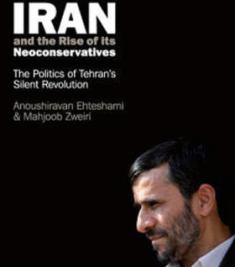|
Reviewed by Henry J. Newman, Ph.D. Candidate at the London School of Economics The post-election turmoil in Iran cannot be properly understood without an appreciation of the current political climate in the country, and particularly of the split in the conservative factions of the Iranian political spectrum. Iran and the Rise of its Neoconservatives seeks to provide a framework for this by detailing the ascent of a new wave of conservative factions in Iran-first in municipal and parliamentary elections and then in the 2005 presidential election victory of Mahmoud Ahmedinejad. The authors discuss how the growth of this fresh wave of conservatism-which they term neoconservativism-challenged both the traditional conservatives of the early republican years, and the reform movement championed by ex-president Muhammad Khatami (1997-2005). Those seeking to understand the political context of Ahmedinejad’s June 2009 ‘election-grabbing’ coup d’état will find much useful material in these pages. The book is a concise and accessible political history. There are sections discussing Ahmedinejad’s family background and his early career; the militarization of politics since the Iran-Iraq War and particularly during Ahmedinejad’s administration; the failures and achievements of the reform movement; and the attractions of Ahmedinejad’s populism. Some of the figures who subsequently became the main players in the 2009 presidential elections including Mohsen Rezaei, Mehdi Karroubi and Hashemi Rafsanjani are examined as well. While the book mainly focuses on the history of the “neoconservative” movement in Iran, some policy analysis is offered, including the various scenarios for US action against Iran’s nuclear program. There is much perspicacious analysis throughout, including prescient deliberation on the possibility for conflict between a reform-minded population and those with a vested interest in guarding the revolution and its ideals. Despite the many strengths and the value of this book, it suffers in places from weak analysis. The authors tend to overstate the importance of electoral politics in Iran and there is insufficient discussion of the limits on Iran’s directly elected institutions deriving from the power of the Supreme Leader. In the forward, reference is made to the “three bases of power”-the municipalities, the parliament and the presidency (p. xvii)-leaving out and/or limiting the focus on other important bases–not least the Supreme Leader himself, the Guardian Council, the Assembly of Experts, the Expediency Council and the judiciary. Although some of these are mentioned, there is no integrated reflection of their roles and their ability to stymie the limited democratic elements within Iranian politics. Unfortunately, the book’s critical lapses go beyond the oversimplification of Iran’s political process. There is no mention of the widespread allegations of electoral irregularities and fraud, above all in the first round of the 2005 presidential election. A section entitled “Mahmoud Ahmedinejad and the ‘Third Revolution’” did not offer a clear analysis of the nature of this revolution; this was particularly disappointing given events since the books publication. Some of the authors’ choices of terms were not entirely felicitous, and deserved at least further explanation. For example, the reformists are described as “liberal”(p. xvi) with no discussion of whether they are liberal relative to other Iranian politicians or to Iranian secular society, or on the basis of the usages of the this term in Europe and America. The very term in the title of the book neoconservatives simply refers to a new wave of conservatism but there is no analysis of the similarities and differences between Iranian neoconservativism and the American philosophical and political movement. Elsewhere the unqualified use of terms such as “regime” (p. 18) is confusing. To whom does this refer-the President, the Supreme Leader or other bodies? Furthermore, there are a number of editorial and orthographic slips. In transliteration the Persian letter ye is inconsistently rendered sometimes as ‘ee’ such as in “Rohaneeyoon” (p. 10) but elsewhere as ‘i’ as on the previous page in “Mojahedine”. (p. 9) The letter ze is misprinted as ‘s’ in “Saseman” (p. 9); the ezafe or possessive is marked ‘-e’ in “Iran-e Farda” (p. 11) but without the hypen in “Enghelabe Eslami” (p. 9); a final n is erroneously added to Mohsen Sazegara(p. 9); and, two spellings are offered for “Mahmoud”. (p. 167) Factual errors can also be found in the text including the author’s statement that six candidates were confirmed by the Guardian Council in the 2005 elections (p. 84), when in reality, the council approved eight with one withdrawing just two days before polling. Finally, the authors’ wording can lead to misunderstandings by readers, such as when they suggest that all voters share both reformist sympathies and frustration at the vetting of candidates by the Guardian Council in the 2004 parliamentary elections. (p. 39) Despite these aforementioned criticisms, readers looking for a solid introduction to contemporary Iranian political history will profit from Iran and the Rise of Its Neoconservatives, finding in it a well reasoned explanation of the rise of a new wave of conservative politics. Those well-versed in Iranian politics may find it somewhat lacking in places, but one cannot contest that the imbroglio of the 2009 elections and the subsequent violent usurpation of power by the “neoconservatives” underscore the significance of what the book’s subtitle appropriately terms “Tehran’s Silent Revolution.” |


 Iran and the Rise of its Neoconservatives: The Politics of Tehran’s Silent Revolution
Iran and the Rise of its Neoconservatives: The Politics of Tehran’s Silent Revolution